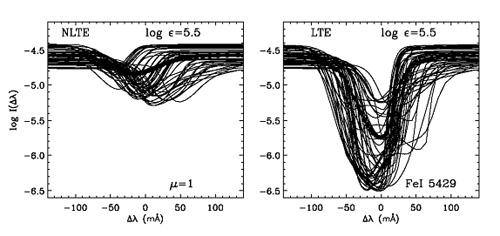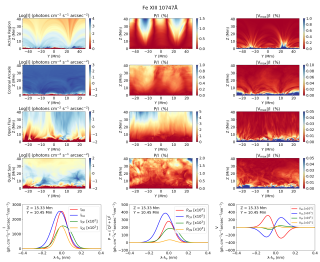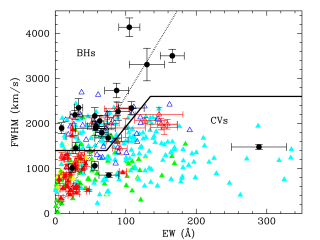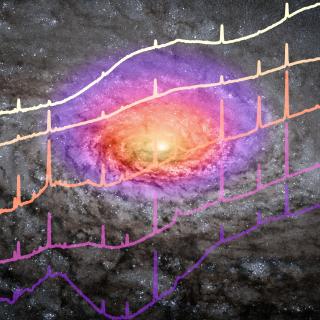Se ha determinado las abundancias del oxígeno y del hierro en estrellas de baja metalicidad mediante simulaciones numéricas de transporte radiativo en modelos tridimensionales hidrodinámicos de las atmósferas de dichas estrellas, sin hacer uso de la aproximación de equilibrio termodinámico local (ETL).
Para poder realizar este tipo de cálculos se tuvo que desarrollar antes métodos y códigos numéricos muy eficientes. El tener en cuenta que las atmósferas estelares son sistemas tridimensionales y el impacto de los efectos del transporte radiativo sin suponer ETL lleva a cambios muy significativos en las abundancias inferidas. Se ha concluido que la metalicidad de algunas estrellas pobres en metales podría ser significativamente mayor que los valores aceptados.
Perfiles de intensidad de una línea del hierro calculados en un modelo 3D hidrodinámico de la atmósfera de una estrella de baja metalicidad, suponiendo ETL (panel derecho) y sin suponer ETL (panel izquierdo). El perfil promedio resultante en cada caso es
Fecha de publicación
Referencias
The Astrophysical Journal, 618:939-952, 2005 January 10
Más información
THE IMPACT OF NON-LTE EFFECTS AND GRANULATION INHOMOGENEITIES ON THE DERIVED IRON AND OXYGEN ABUNDANCES IN METAL-POOR HALO STARS
This paper presents the results of a detailed theoretical investigation of the impact of non-LTE (NLTE) effects and of granulation inhomogeneities on the derived iron and oxygen abundances in the metal-poor halo subgiant HD 140283. Our analysis is based on both the ‘‘classical’’ one-dimensional stellar atmosphere models and on the new generation of three-dimensional hydrodynamic models. The NLTE calculations presented here have been carried out without inelastic collisions with neutral hydrogen atoms. We find that if NLTE effects are taken into account when synthesizing the Fe i spectrum in both types of atmospheric models, then the derived iron abundance turns out to be very similar in both cases. The emergent spectral line profiles in both models are very much weaker in NLTE than in LTE because the UV overionization mechanism produces a very strong underpopulation of the Fe i levels, in particular in the granular regions of the three-dimensional model. As a result, the NLTE effects on the derived iron abundance are very important, amounting to 0.9 and to 0.6 dex in the three- and one-dimensional cases, respectively. On the other hand, we find that NLTE and three-dimensional effects have to be taken into account for a reliable determination of the iron abundance from weak Fe ii lines, because the significant overexcitation of their upper levels in the granular regions tend to produce emission features. As a result, such Fe ii lines are weaker than in LTE and the abundance correction amounts to 0.4 dex for the three-dimensional case. We also derive the oxygen-to-iron abundance ratio in the metal-poor star HD 140283 by using the O i triplet at 7772–7775 8 and the forbidden [O i] line at 6300 8. Our results for the oxygen abundance confirm the values reported in some recent investigations. While the oxygen abundance derived from the O i IR triplet is not very sensitive to the presence of granulation inhomogeneities, such three-dimensional effects amount to 0.2 dex for the [O i] line. The NLTE abundance correction for the O i IR triplet turns out to be 0.2 dex, approximately. Interestingly, when both NLTE and three-dimensional effects are taken into account there still remain significant discrepancies in the iron abundances derived from Fe i and Fe ii lines, as well as in the oxygen abundances inferred from the O i and [O i] lines. We conclude that the discrepancies could be due to uncertainties in the stellar parameters of this metal-poor star. We argue that adopting TeA 5600 K (instead of TeA 5700 K) and ½Fe=H2:0 (instead of ½Fe=H 2:5) substantially reduces the discrepancies in the abundances of iron and oxygen inferred from several spectral lines. Under such circumstances, we find ½O=Fe 0:5 at ½Fe=H¼2. Obviously, our tentative conclusion that the metallicity of this type of metal-poor star is significantly larger than previously thought may have far-reaching implications in stellar astrophysics.
Año
2005



